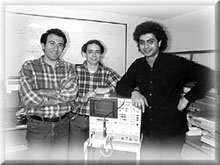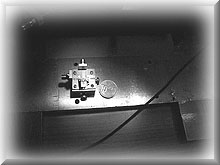 The average hair has a thickness of 50 microns, which is one-twentieth of a millimeter. So, would you believe it if somebody told you that they produced a microphone as small as 40 microns in diameter? Believe it or not, someone has produced the smallest microphone in the world, a group of researchers right here at Bilkent, to be exact.
The average hair has a thickness of 50 microns, which is one-twentieth of a millimeter. So, would you believe it if somebody told you that they produced a microphone as small as 40 microns in diameter? Believe it or not, someone has produced the smallest microphone in the world, a group of researchers right here at Bilkent, to be exact.
The group achieved the breakthrough by using Silicon Micromachining: the immature but promising outcome of integrated circuit technology. Silicon Micromachining is the "art" of producing micron-sized mechanical structures (or machines) on a silicon wafer, a tiny slice from a massive block of purified and hardened sand. Those slices are conventionally used to fabricate chips (like computer memory), but with all of the advanced and well-developed tools used to process them and a pinch of ingenuity, one can find ways of producing fantastic micron-sized devices that include electric motors, various sensing instruments, and microphones.
The joint research project of the Electrical Engineering and Physics departments led by Dr. Abdullah Atalar and Dr. Ekmel Özbay produced its first outcome last week. The first silicon micromachined ultrasonic transducer (which is the technical term for a microphone that is able to pick up sound beyond human hearing range) fabricated in the clean room of the Advanced Research Lab was tested and found to be operational by research assistants Ayhan Bozkurt, Sanlý Ergun, and Burak Temelkuran.
 The device consists of about 24,000 micron-sized vibrating membranes forming a honey-comb like structure on a chip area of 7mm by 7mm, about one-tenth of the surface of a TL 10,000 coin.
"We are glad to see that the device has a performance that is better than the versions reported so far by various research groups" said Bozkurt, who will earn his Ph.D out of this work, "and all is done by the tools and know-how of Bilkent." Bozkurt said the micro-microphones could have a variety of applications ranging from medical to military because they can inexpensively capture high-frequency sound and translate those sounds into images.
The device consists of about 24,000 micron-sized vibrating membranes forming a honey-comb like structure on a chip area of 7mm by 7mm, about one-tenth of the surface of a TL 10,000 coin.
"We are glad to see that the device has a performance that is better than the versions reported so far by various research groups" said Bozkurt, who will earn his Ph.D out of this work, "and all is done by the tools and know-how of Bilkent." Bozkurt said the micro-microphones could have a variety of applications ranging from medical to military because they can inexpensively capture high-frequency sound and translate those sounds into images.
Silicon micromachined transducers will soon replace their conventional piezo-electric counterparts because of two factors: First, they perform better and will enable the production of imaging and medical diagnostics equipment that only exist in dreams with current technology. Secondly, chip foundries are all around and all shores are full of sand, thus they are cheap!
As for the future of silicon micromachining? Well, sky is the limit! But what we are sure about the near future is that such amazing and useful devices as intravenous submarines are on the way!
Editor's note: Bilkent News urges all university researchers to share the results of their work through these pages.








